BUSM4614 Project Design for Quality: Starbucks Case Study Essay
VerifiedAdded on 2023/05/30
|5
|1368
|226
Essay
AI Summary
This essay examines the concept of quality through a detailed analysis of Starbucks, a global coffeehouse company. The paper begins by defining quality as excellence and freedom from defects, then proceeds to analyze Starbucks' operations, from its inception in 1971, focusing on how the company applies quality principles to coffee roasting, manufacturing, and delivery. The essay explores David A. Garvin's eight dimensions of quality—performance, features, reliability, conformance, durability, serviceability, aesthetics, and perceived quality—demonstrating how Starbucks adheres to these standards through its sourcing of premium coffee beans, its supply chain management, and its commitment to customer experience. The analysis covers various aspects of Starbucks' operations, including the roasting and blending processes, the delivery of coffee, and the company's adaptations to maintain quality and meet customer expectations. The essay references several sources to support its arguments, ultimately highlighting Starbucks' commitment to providing a high-quality experience.
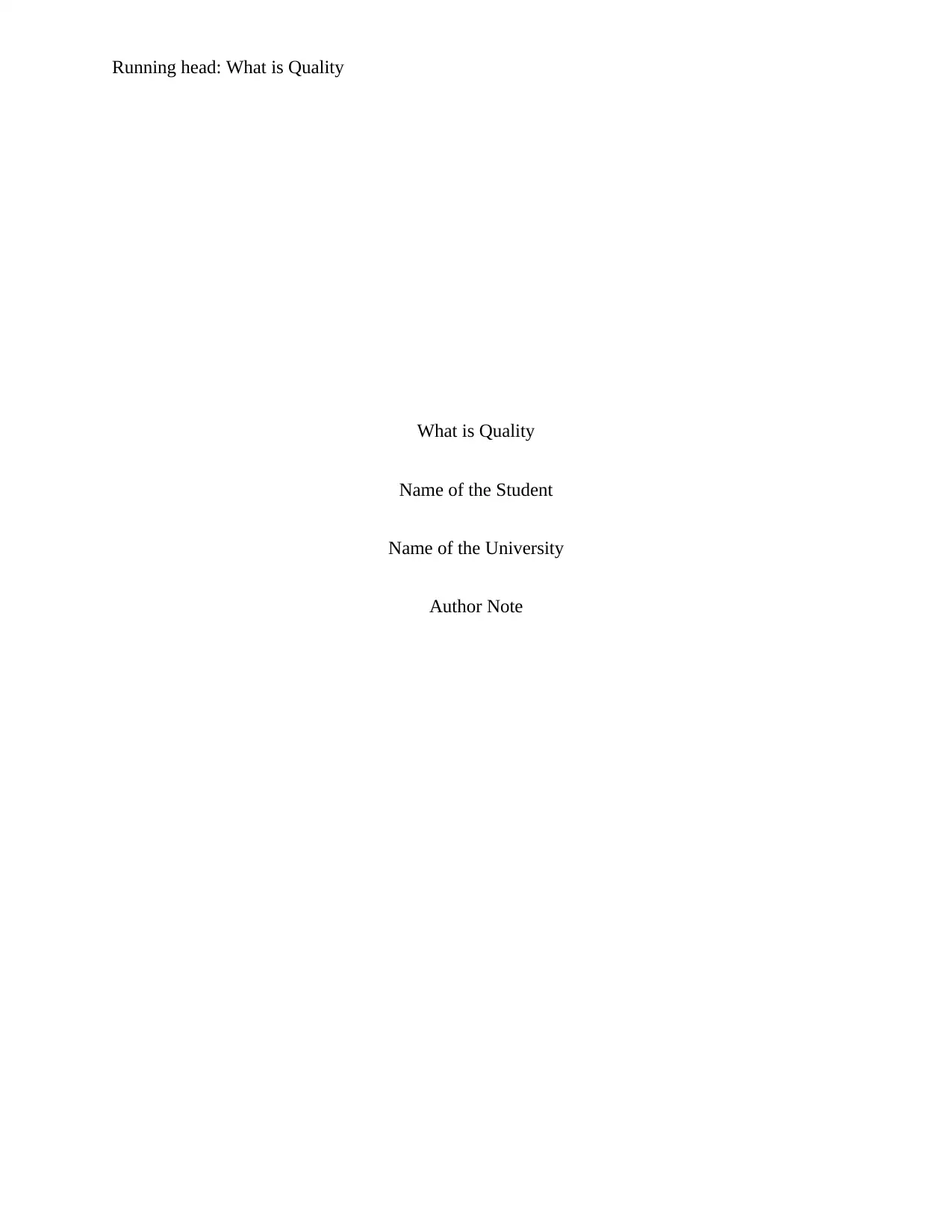
Running head: What is Quality
What is Quality
Name of the Student
Name of the University
Author Note
What is Quality
Name of the Student
Name of the University
Author Note
Paraphrase This Document
Need a fresh take? Get an instant paraphrase of this document with our AI Paraphraser
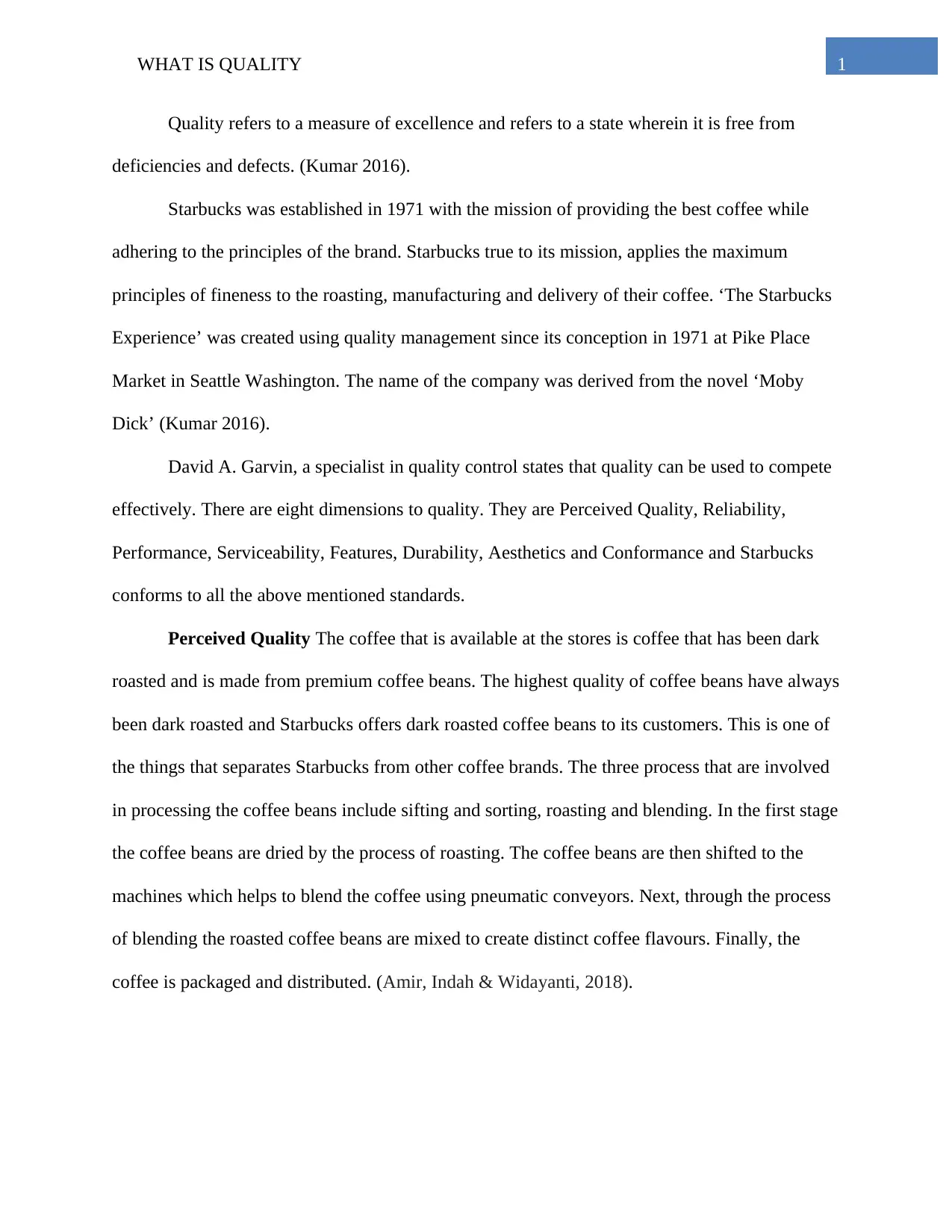
1WHAT IS QUALITY
Quality refers to a measure of excellence and refers to a state wherein it is free from
deficiencies and defects. (Kumar 2016).
Starbucks was established in 1971 with the mission of providing the best coffee while
adhering to the principles of the brand. Starbucks true to its mission, applies the maximum
principles of fineness to the roasting, manufacturing and delivery of their coffee. ‘The Starbucks
Experience’ was created using quality management since its conception in 1971 at Pike Place
Market in Seattle Washington. The name of the company was derived from the novel ‘Moby
Dick’ (Kumar 2016).
David A. Garvin, a specialist in quality control states that quality can be used to compete
effectively. There are eight dimensions to quality. They are Perceived Quality, Reliability,
Performance, Serviceability, Features, Durability, Aesthetics and Conformance and Starbucks
conforms to all the above mentioned standards.
Perceived Quality The coffee that is available at the stores is coffee that has been dark
roasted and is made from premium coffee beans. The highest quality of coffee beans have always
been dark roasted and Starbucks offers dark roasted coffee beans to its customers. This is one of
the things that separates Starbucks from other coffee brands. The three process that are involved
in processing the coffee beans include sifting and sorting, roasting and blending. In the first stage
the coffee beans are dried by the process of roasting. The coffee beans are then shifted to the
machines which helps to blend the coffee using pneumatic conveyors. Next, through the process
of blending the roasted coffee beans are mixed to create distinct coffee flavours. Finally, the
coffee is packaged and distributed. (Amir, Indah & Widayanti, 2018).
Quality refers to a measure of excellence and refers to a state wherein it is free from
deficiencies and defects. (Kumar 2016).
Starbucks was established in 1971 with the mission of providing the best coffee while
adhering to the principles of the brand. Starbucks true to its mission, applies the maximum
principles of fineness to the roasting, manufacturing and delivery of their coffee. ‘The Starbucks
Experience’ was created using quality management since its conception in 1971 at Pike Place
Market in Seattle Washington. The name of the company was derived from the novel ‘Moby
Dick’ (Kumar 2016).
David A. Garvin, a specialist in quality control states that quality can be used to compete
effectively. There are eight dimensions to quality. They are Perceived Quality, Reliability,
Performance, Serviceability, Features, Durability, Aesthetics and Conformance and Starbucks
conforms to all the above mentioned standards.
Perceived Quality The coffee that is available at the stores is coffee that has been dark
roasted and is made from premium coffee beans. The highest quality of coffee beans have always
been dark roasted and Starbucks offers dark roasted coffee beans to its customers. This is one of
the things that separates Starbucks from other coffee brands. The three process that are involved
in processing the coffee beans include sifting and sorting, roasting and blending. In the first stage
the coffee beans are dried by the process of roasting. The coffee beans are then shifted to the
machines which helps to blend the coffee using pneumatic conveyors. Next, through the process
of blending the roasted coffee beans are mixed to create distinct coffee flavours. Finally, the
coffee is packaged and distributed. (Amir, Indah & Widayanti, 2018).
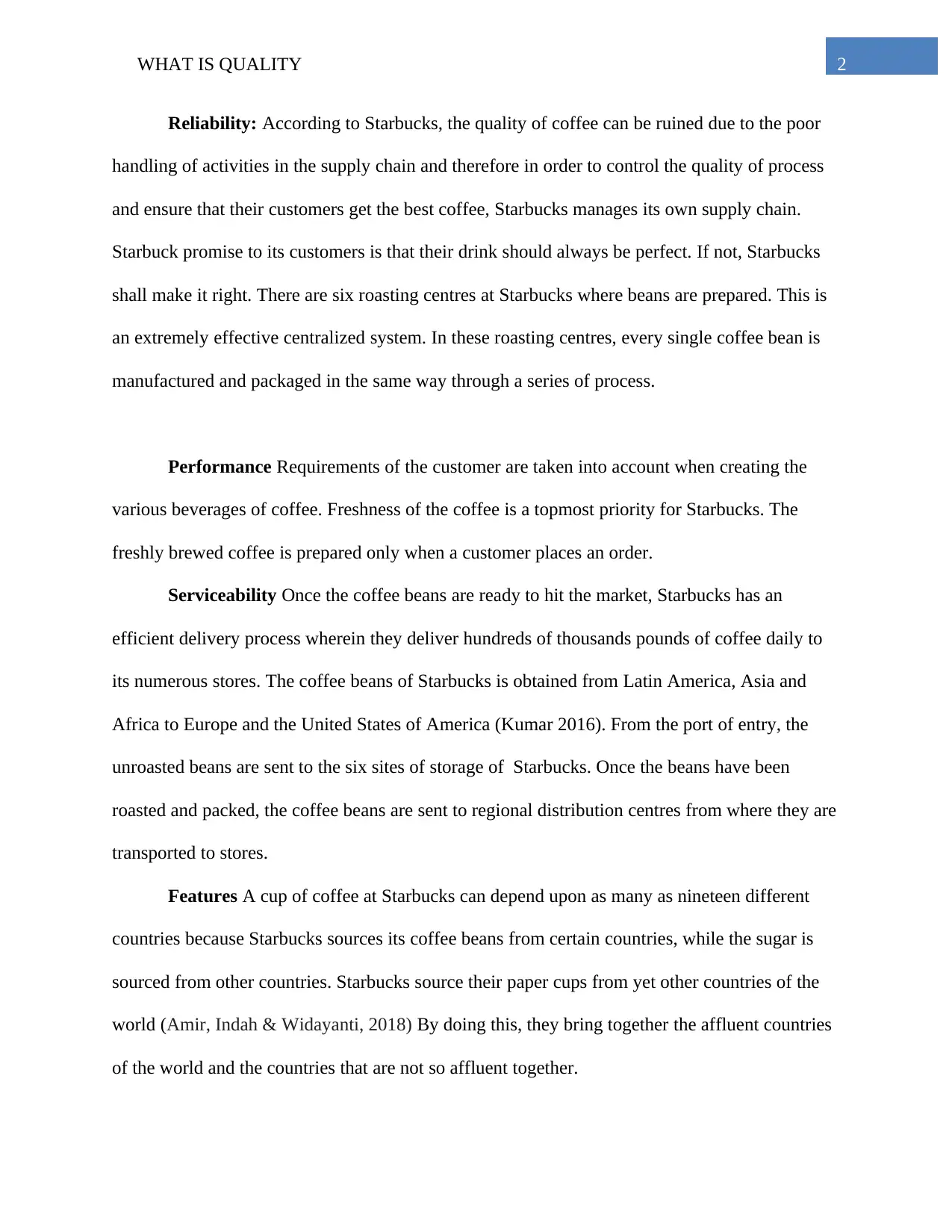
2WHAT IS QUALITY
Reliability: According to Starbucks, the quality of coffee can be ruined due to the poor
handling of activities in the supply chain and therefore in order to control the quality of process
and ensure that their customers get the best coffee, Starbucks manages its own supply chain.
Starbuck promise to its customers is that their drink should always be perfect. If not, Starbucks
shall make it right. There are six roasting centres at Starbucks where beans are prepared. This is
an extremely effective centralized system. In these roasting centres, every single coffee bean is
manufactured and packaged in the same way through a series of process.
Performance Requirements of the customer are taken into account when creating the
various beverages of coffee. Freshness of the coffee is a topmost priority for Starbucks. The
freshly brewed coffee is prepared only when a customer places an order.
Serviceability Once the coffee beans are ready to hit the market, Starbucks has an
efficient delivery process wherein they deliver hundreds of thousands pounds of coffee daily to
its numerous stores. The coffee beans of Starbucks is obtained from Latin America, Asia and
Africa to Europe and the United States of America (Kumar 2016). From the port of entry, the
unroasted beans are sent to the six sites of storage of Starbucks. Once the beans have been
roasted and packed, the coffee beans are sent to regional distribution centres from where they are
transported to stores.
Features A cup of coffee at Starbucks can depend upon as many as nineteen different
countries because Starbucks sources its coffee beans from certain countries, while the sugar is
sourced from other countries. Starbucks source their paper cups from yet other countries of the
world (Amir, Indah & Widayanti, 2018) By doing this, they bring together the affluent countries
of the world and the countries that are not so affluent together.
Reliability: According to Starbucks, the quality of coffee can be ruined due to the poor
handling of activities in the supply chain and therefore in order to control the quality of process
and ensure that their customers get the best coffee, Starbucks manages its own supply chain.
Starbuck promise to its customers is that their drink should always be perfect. If not, Starbucks
shall make it right. There are six roasting centres at Starbucks where beans are prepared. This is
an extremely effective centralized system. In these roasting centres, every single coffee bean is
manufactured and packaged in the same way through a series of process.
Performance Requirements of the customer are taken into account when creating the
various beverages of coffee. Freshness of the coffee is a topmost priority for Starbucks. The
freshly brewed coffee is prepared only when a customer places an order.
Serviceability Once the coffee beans are ready to hit the market, Starbucks has an
efficient delivery process wherein they deliver hundreds of thousands pounds of coffee daily to
its numerous stores. The coffee beans of Starbucks is obtained from Latin America, Asia and
Africa to Europe and the United States of America (Kumar 2016). From the port of entry, the
unroasted beans are sent to the six sites of storage of Starbucks. Once the beans have been
roasted and packed, the coffee beans are sent to regional distribution centres from where they are
transported to stores.
Features A cup of coffee at Starbucks can depend upon as many as nineteen different
countries because Starbucks sources its coffee beans from certain countries, while the sugar is
sourced from other countries. Starbucks source their paper cups from yet other countries of the
world (Amir, Indah & Widayanti, 2018) By doing this, they bring together the affluent countries
of the world and the countries that are not so affluent together.
⊘ This is a preview!⊘
Do you want full access?
Subscribe today to unlock all pages.

Trusted by 1+ million students worldwide
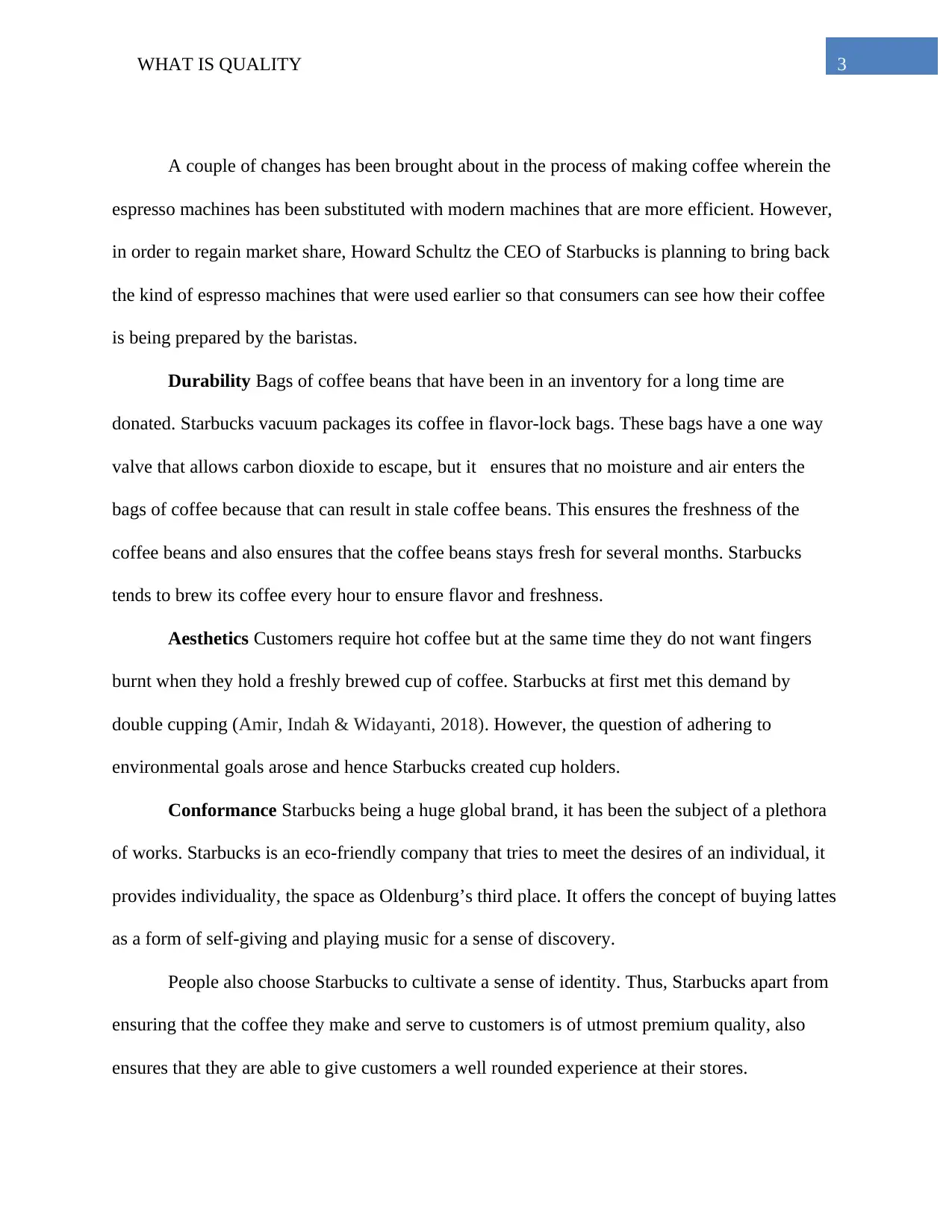
3WHAT IS QUALITY
A couple of changes has been brought about in the process of making coffee wherein the
espresso machines has been substituted with modern machines that are more efficient. However,
in order to regain market share, Howard Schultz the CEO of Starbucks is planning to bring back
the kind of espresso machines that were used earlier so that consumers can see how their coffee
is being prepared by the baristas.
Durability Bags of coffee beans that have been in an inventory for a long time are
donated. Starbucks vacuum packages its coffee in flavor-lock bags. These bags have a one way
valve that allows carbon dioxide to escape, but it ensures that no moisture and air enters the
bags of coffee because that can result in stale coffee beans. This ensures the freshness of the
coffee beans and also ensures that the coffee beans stays fresh for several months. Starbucks
tends to brew its coffee every hour to ensure flavor and freshness.
Aesthetics Customers require hot coffee but at the same time they do not want fingers
burnt when they hold a freshly brewed cup of coffee. Starbucks at first met this demand by
double cupping (Amir, Indah & Widayanti, 2018). However, the question of adhering to
environmental goals arose and hence Starbucks created cup holders.
Conformance Starbucks being a huge global brand, it has been the subject of a plethora
of works. Starbucks is an eco-friendly company that tries to meet the desires of an individual, it
provides individuality, the space as Oldenburg’s third place. It offers the concept of buying lattes
as a form of self-giving and playing music for a sense of discovery.
People also choose Starbucks to cultivate a sense of identity. Thus, Starbucks apart from
ensuring that the coffee they make and serve to customers is of utmost premium quality, also
ensures that they are able to give customers a well rounded experience at their stores.
A couple of changes has been brought about in the process of making coffee wherein the
espresso machines has been substituted with modern machines that are more efficient. However,
in order to regain market share, Howard Schultz the CEO of Starbucks is planning to bring back
the kind of espresso machines that were used earlier so that consumers can see how their coffee
is being prepared by the baristas.
Durability Bags of coffee beans that have been in an inventory for a long time are
donated. Starbucks vacuum packages its coffee in flavor-lock bags. These bags have a one way
valve that allows carbon dioxide to escape, but it ensures that no moisture and air enters the
bags of coffee because that can result in stale coffee beans. This ensures the freshness of the
coffee beans and also ensures that the coffee beans stays fresh for several months. Starbucks
tends to brew its coffee every hour to ensure flavor and freshness.
Aesthetics Customers require hot coffee but at the same time they do not want fingers
burnt when they hold a freshly brewed cup of coffee. Starbucks at first met this demand by
double cupping (Amir, Indah & Widayanti, 2018). However, the question of adhering to
environmental goals arose and hence Starbucks created cup holders.
Conformance Starbucks being a huge global brand, it has been the subject of a plethora
of works. Starbucks is an eco-friendly company that tries to meet the desires of an individual, it
provides individuality, the space as Oldenburg’s third place. It offers the concept of buying lattes
as a form of self-giving and playing music for a sense of discovery.
People also choose Starbucks to cultivate a sense of identity. Thus, Starbucks apart from
ensuring that the coffee they make and serve to customers is of utmost premium quality, also
ensures that they are able to give customers a well rounded experience at their stores.
Paraphrase This Document
Need a fresh take? Get an instant paraphrase of this document with our AI Paraphraser
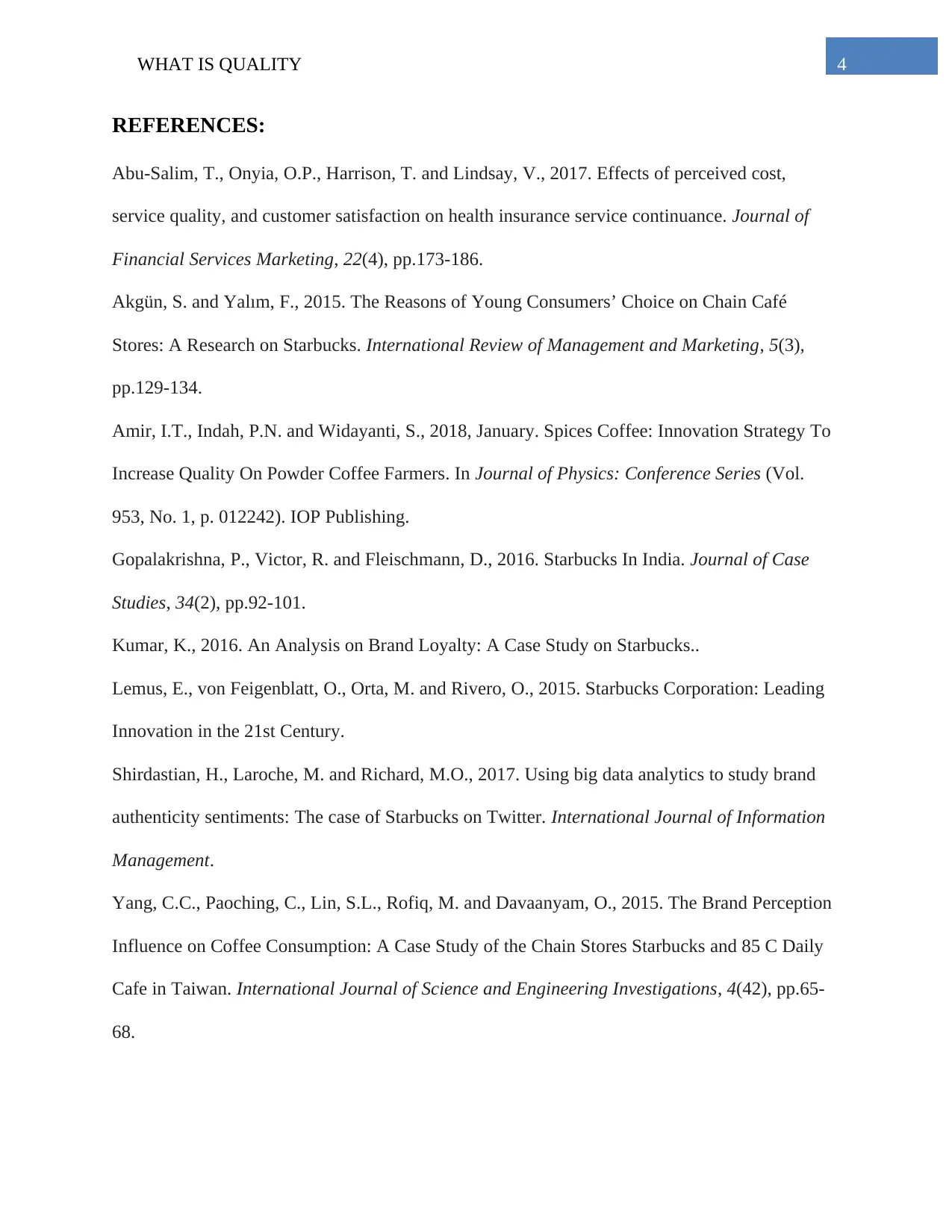
4WHAT IS QUALITY
REFERENCES:
Abu-Salim, T., Onyia, O.P., Harrison, T. and Lindsay, V., 2017. Effects of perceived cost,
service quality, and customer satisfaction on health insurance service continuance. Journal of
Financial Services Marketing, 22(4), pp.173-186.
Akgün, S. and Yalım, F., 2015. The Reasons of Young Consumers’ Choice on Chain Café
Stores: A Research on Starbucks. International Review of Management and Marketing, 5(3),
pp.129-134.
Amir, I.T., Indah, P.N. and Widayanti, S., 2018, January. Spices Coffee: Innovation Strategy To
Increase Quality On Powder Coffee Farmers. In Journal of Physics: Conference Series (Vol.
953, No. 1, p. 012242). IOP Publishing.
Gopalakrishna, P., Victor, R. and Fleischmann, D., 2016. Starbucks In India. Journal of Case
Studies, 34(2), pp.92-101.
Kumar, K., 2016. An Analysis on Brand Loyalty: A Case Study on Starbucks..
Lemus, E., von Feigenblatt, O., Orta, M. and Rivero, O., 2015. Starbucks Corporation: Leading
Innovation in the 21st Century.
Shirdastian, H., Laroche, M. and Richard, M.O., 2017. Using big data analytics to study brand
authenticity sentiments: The case of Starbucks on Twitter. International Journal of Information
Management.
Yang, C.C., Paoching, C., Lin, S.L., Rofiq, M. and Davaanyam, O., 2015. The Brand Perception
Influence on Coffee Consumption: A Case Study of the Chain Stores Starbucks and 85 C Daily
Cafe in Taiwan. International Journal of Science and Engineering Investigations, 4(42), pp.65-
68.
REFERENCES:
Abu-Salim, T., Onyia, O.P., Harrison, T. and Lindsay, V., 2017. Effects of perceived cost,
service quality, and customer satisfaction on health insurance service continuance. Journal of
Financial Services Marketing, 22(4), pp.173-186.
Akgün, S. and Yalım, F., 2015. The Reasons of Young Consumers’ Choice on Chain Café
Stores: A Research on Starbucks. International Review of Management and Marketing, 5(3),
pp.129-134.
Amir, I.T., Indah, P.N. and Widayanti, S., 2018, January. Spices Coffee: Innovation Strategy To
Increase Quality On Powder Coffee Farmers. In Journal of Physics: Conference Series (Vol.
953, No. 1, p. 012242). IOP Publishing.
Gopalakrishna, P., Victor, R. and Fleischmann, D., 2016. Starbucks In India. Journal of Case
Studies, 34(2), pp.92-101.
Kumar, K., 2016. An Analysis on Brand Loyalty: A Case Study on Starbucks..
Lemus, E., von Feigenblatt, O., Orta, M. and Rivero, O., 2015. Starbucks Corporation: Leading
Innovation in the 21st Century.
Shirdastian, H., Laroche, M. and Richard, M.O., 2017. Using big data analytics to study brand
authenticity sentiments: The case of Starbucks on Twitter. International Journal of Information
Management.
Yang, C.C., Paoching, C., Lin, S.L., Rofiq, M. and Davaanyam, O., 2015. The Brand Perception
Influence on Coffee Consumption: A Case Study of the Chain Stores Starbucks and 85 C Daily
Cafe in Taiwan. International Journal of Science and Engineering Investigations, 4(42), pp.65-
68.
1 out of 5
Related Documents
Your All-in-One AI-Powered Toolkit for Academic Success.
+13062052269
info@desklib.com
Available 24*7 on WhatsApp / Email
![[object Object]](/_next/static/media/star-bottom.7253800d.svg)
Unlock your academic potential
Copyright © 2020–2025 A2Z Services. All Rights Reserved. Developed and managed by ZUCOL.




